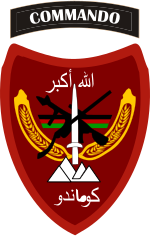The Afghan National Army Commando Corps (formerly ANA Commando Brigade;[5] ANA Commando Battalion[4]) was a commando force of the Afghan National Army (ANA). During the Taliban insurgency, the commandos comprised 7% of the Afghan National Security Forces but conducted 70% to 80% of the fighting.[6] The structure of the unit was based on the U.S. Army's 75th Ranger Regiment.[7]
| Afghan National Army Commando Corps قول اردوی عملیاتهای خاص | |
|---|---|
 Shoulder sleeve insignia | |
| Active | 24 July 2007 – 15 August 2021 |
| Country | |
| Branch | Afghan National Army |
| Type | Commando |
| Role | Close-quarters combat Counter-insurgency Counterterrorism |
| Size | 21,000 commandos (2017)[1][2] 30,000 commandos (2021)[3] |
| Part of | ANA Special Operations Command |
| Headquarters | Rish Khor camp (Camp Morehead), Kabul Province, Afghanistan[4] |
| Motto(s) | Khoda, Watan, Wazifa |
| Engagements | War in Afghanistan (2001–2021) |
| Insignia | |
| Corps flag |  |
Upon the fall of Kabul and the collapse of both the ANA and Islamic Republic of Afghanistan in August 2021, the Commando Corps was dissolved.
Selection and training
The first commando battalion was formed from existing infantry battalions. In early 2007, a program began to take one conventional infantry kandak (battalion) from each of the regional ANA corps, give them special training and equipment, and reorganise them based on the 75th Ranger Regiment of the United States Army. Each battalion was assigned to one of the six regional corps.
Training was conducted at the Morehead Commando Training Center (Rish Khor camp), a longtime former Afghan Army installation located ten kilometres (six miles) south of Kabul. The camp was reported as being in either Wardak Province or Kabul Province.[8]
The 12-week course ran three separate training programmes for different parts of the nascent unit at the same time. The primary and bulk of the training was geared for the infantry toli (company), with a focus on individual skills and small unit tactics. To support the fighting companies, the headquarters and headquarters toli received other training such as in mortars, medical care, and communications. The third section focused on the kandak staff and their command and control functions.[9]
The unit recruited from various ANA units all over Afghanistan, taking in prospective Pashtuns, Tajik, Hazara, Uzbek, and Turkmen to prevent forms of tribal allegiance and bias.[7]
The first commando kandak graduated on July 24, 2007, with Colonel Fareed Ahmadi as its commander.[10] Upon graduation, each commando kandak returned to its designated corps area along with an embedded U.S. Army Special Forces A-Team, and began going through an 18-week cycle: six weeks each of train-up, missions, and recovery. Both the U.S. 3rd Special Forces Group and 7th Special Forces Group rotated responsibility to train and advise in Afghanistan.[11]
While the original plan by the International Security Assistance Force (ISAF) was for one brigade with six kandaks, the ANA wanted a full division with three brigades and 15 kandaks.[12]
After the fall of Kabul in 2021
During the 2021 Taliban offensive, 22 commandos were executed by the Taliban in the Faryab Province after surrendering.[13] While the Taliban were known to show leniency to regular ANA troops, commandos and Afghan Air Force pilots were especially targeted by the Taliban.[14]
Some remnants of the ANA regrouped in the Panjshir Valley, where they joined the anti-Taliban National Resistance Front of Afghanistan.[15] Around 500–600 remaining Afghan troops, made up mostly of Afghan commandos, were reported to have refused to surrender to the Taliban in Kabul, and instead joined up with U.S. forces at Kabul International Airport, helping them secure the outer perimeter of the airport during the evacuation in August 2021.[16]
Some Afghan commandos were evacuated to the United Kingdom. On 1 September 2021, Forbes reported that the UK was contemplating recruiting such evacuated commandos into the British Army.[17]
In October 2022, the Russian Armed Forces reportedly started to recruit former Afghan commandos for the war in Ukraine.[18] In November that same year, it was reported that Iran was also recruiting former commandos for use in Yemen, primarily those who had fled into Iran during the 2021 Taliban offensive.[19]
Notes
References

- Neville, Leigh (2019). The Elite: The A–Z of Modern Special Operations Forces. Oxford: Osprey Publishing. ISBN 978-1472824295.